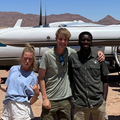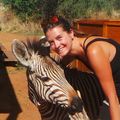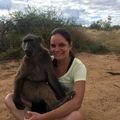Wildlife Conservation
Their vision is an Africa where humans and wildlife can live and thrive together. Their mission is to conserve the land, cultures and wildlife of Namibia and rescue species threatened by an ever-shrinking habitat.
Their vision is an Africa where humans and wildlife can live and thrive together. Their mission is to conserve the land, cultures and wildlife of Namibia and rescue species threatened by an ever-shrinking habitat.

| Location | Closest town: Windhoek, Namibia |
|---|---|
| Duration | From 2 - 12 weeks |
| Dates | All year round |
| Requirements |
|
| Minimum Age: | 18 |
| Your impact | |
| Documents required | Enrolment form, curriculum vitae, letter of motivation, passport copy, proof of medical insurance, (all travellers to Namibia are required to have a valid passport) |
| Day of arrival | Saturday |
| Day of departure | Saturday |
This project, situated on a 3,200 hectare reserve near Windhoek, provides a safe haven for orphaned and injured African wildlife. The Wildlife Sanctuary provides a haven and second chance for countless injured, orphaned and human-wildlife conflict animals. Wherever possible the aim is to release animals back into the wild. This is aimed to be achieved through encouraging participation, education and scientific research. The project strongly believes that wildlife belongs in the wild and they direct all their efforts towards long-term rehabilitation. But sadly, not all of the animals that come to this sanctuary are able to be released back into the wild. Those that can’t be released remain in the sanctuary to be taken care of and to live out thier lifespan at the sanctuary.
During your time at the sanctuary, you will feed and provide enrichment to the animals, as well as clean and maintain their enclosures, but you also get the opportunity to spend time on their vast reserve where some of the animals previously housed at the sanctuary have been released. Here you go out on the reserve to track the high-profile species on foot, go on game counts and help with any other projects that may come up. You have the rare and exciting opportunity to work closely with animals and to participate actively in the conservation of African wildlife.
You may also be given the chance to assist the primary school teachers with a sporting activity with the school children if you wish.
The sanctuary currently provides a safe refuge for orphaned and injured wildlife, including a number of lions, leopards, cheetahs, wild dogs, caracals, white rhinos, elephants, baboons, banded mongoose, often a warthog and meerkats as well as some domestic animals such as donkeys, sheep and goats. You play an important role, caring for and feeding the animals on a daily basis, and helping to clean, maintain and develop the sanctuary and the property.
"Conservation Through Innovation": The project strives to create sustainable and long-term solutions. It is their vision to play a proactive role in nature conservation because they believe that they hold this invaluable heritage in their trust for future generations. They rely solely on generous donations and on the time given by volunteers to continue their vital work to help the people and animals of Namibia.
Activities at the sanctuary are carried out using a rotational group system to ensure that everybody gets exposed to the variety of experiences available. Volunteers are split into groups of 4-5 people. They are assigned to these groups for the duration of their stay and rotate through activities on a daily basis.
Possible tasks could include:
A possible working schedule could be:
Monday to Saturday:
Saturday afternoons are usually reserved for fun team building activities with coordinators and volunteers.
Sunday:
It is important to note that this description serves as an example only. The daily tasks and challenges depend on the volunteer, the time of the year and the work that needs to be done. The final job description can therefore vary substantially from the above.
This project may be combined with one of our exciting add-on projects. add-on projects
Two types of accommodation are offered:
The rooms are basic, but the single beds are comfortable; towels and bedding is provided (duvets and pillows). Showers and toilet facilities are communal and the hot water is heated by solar energy and is therefore sometimes restricted.
Electricity is freely available. However, please be aware that sometimes the electricity supply can be cut off during storms. Power sockets for electrical items are available in communal areas.
Laundry service is also available.
WiFi is available on the farm with the purchase of Wi-Fi coupons at the onsite coffee shop, however the connection may be unstable at times.

Willem from the Netherlands
“I had a great time here. The people you work with, the staff, they are all amazing! Walking with the baboons and skydiving above the ocean, you do everything! Recommend it to everyone. You get the feeling that you really help the country.“

Ravi from the Netherlands
“The Namibia Wildlife Conservation project and its sub-projects is part of an organization that I recommend to everyone, it doesn’t matter what age you are. It’s the perfect mix of volunteer work and doing fun stuff. The staff is also very nice and the accommodations as well! It was the best trip of my life.”

Jasmine from Switzerland
„The most interesting thing at the Namibia Wildlife Conservation project was working with the animals and the collaboration with the employees. Everyday was different because of the tasks and the experience you make every single day. I enjoyed learning more about the animals and feeding them.“

Stach from the Netherlands
„I have fond memories of the special experiences during the weekly activities at the project. Highlights were: counting rhino’s from the plane with the director, the night drives (we spotted owl, rhino and elephant) and the game count on horseback. It was very interesting to help the vet with the health-checks, darting and care for the caracal. Taking care of Hamlet, the baby warthog was really nice too.
The atmosphere in the lapa was relaxed and friendly, we had a lot of fun playing card games.
It gave me a special feeling and a sense of purpose to be connected with African wild animals and animals in captivity and to learn how to improve their living conditions and to look at their behavior. For who appreciates to be outside and likes adventure, this is an amazing opportunity.“

Florian from The Netherlands
„I really enjoyed the beautiful 6 weeks on safari. I learned a lot about the animals there and made incredible things with it. Unfortunately the other volunteers weren't my best friends but that didn't matter because you had plenty of things that were beautiful. I will definitely come back to the Wildlife Conservation Project with my friends. I really recommended it!! Hopefully I'll see you soon again!“

Kamila from Mexico
"Hi! I’m Kamila from Mexico City. In January I had the opportunity to participate as a volunteer at the Wildlife Conservation project as a solo traveller and it was the best decision of my life! Being able to work with wild animals so close has been the best experience! I had the chance to meet incredible people from all over the world. It's amazing how all the workers and volunteers welcome you as a family. Working with this beautiful and docile animals is an experience I will never forget!"

Tamara from France
"My dream is to return in Namibia. This adventure was amazing. I met extraordinary people who are passionate about nature and animal. The three weeks in the Namibian wildlife project where I discovered of Africa, animals and work. I will never forget taking care of a three years old baboon or when I helped the vet rescue a wild dog. Africa is a wonderful continent with stunning scennery, animals and friendly people, but also a country where wildlife is endangered and I'm proud to have help (a little) for its conservation."

Vivian from Brazil
"Namibia Wildlife Conservation is a very special project, starting with its location - a beautiful place with a fantastic landscape, far from civilization and filled with many, many animals! For me it was simply delightful being surrounded by them and to learn, every day, something new.
My favorite activities were those involving the baboons, animals with which we ended up having more interaction in the project. Being able to sleep with a cub was something I never imagined doing in life; Walk with monkeys hanging on your shoulders, hugging you and even receive a "kiss" of them was surreal! And of course, the image of zebras, giraffes, ostriches, wild boars, oyrixes, running loose by the reserve will be forever in my memory.
I made friends, I met people from all over the world, all with an immense love for life and nature, and I feel that I have returned richer from this trip. Volunteer exchange is something that everyone should experience someday. We live in a world very helpless and sometimes the little we give makes a big difference for those who need it."